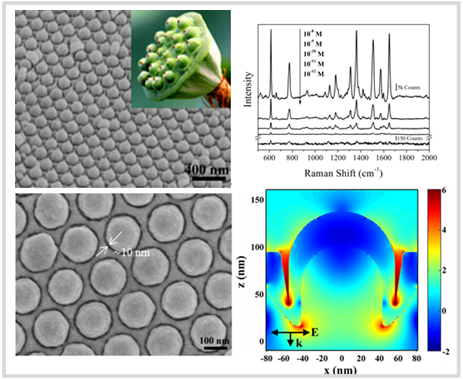Surface-enhanced Raman Spectroscopy (SERS) is an ultrasensitive analytical tool that provides fingerprint information for molecular diagnostics. SERS phenomenon is based on light excitation of surface plasmon resonances that induces an enhanced electromagnetic field at noble-metal nanostructures. Particularly, enormous electromagnetic fields enhancement can be found in sub-10 nm gaps and at sharp tips, typically referred to as “hot spots”. Once target molecules are placed inside these hot spots, their Raman signals would be dramatically amplified.
Generally, there is inevitably a trade-off between field enhancement and reproducibility. It is therefore highly desired to fabricate SERS substrates with sub-10 nm nanogaps as well as uniformly and stably distributed hot spots.
Very recently, Junhui He’s Group presented in Advanced Optical Materials (DOI: adom.201800056) the fabrication of large-area, hexagonal-packed lotus seedpod like (LSP) array with adjustable nanogaps via the nanosphere lithography procedure and Ag sputtering, which is precise, convenient and cost-effective. Thanks to the uniform and high-density distribution of sub-10 nm nanogaps on the LSP array substrate, they had achieved ultrasensitive (10-12 M) and reproducible SERS signals of R6G. Finite-different time-domain (FDTD) simulations indicated that the precisely controlled sub-10 nm 3-D annular nanogaps were mainly responsible for the electric field enhancement. Furthermore, the fabricated LSP array substrate provided highly sensitive Raman signals in label-free detection of Aβ oligomers.

This work was financially supported by the National Key Research and Development Program of China (2017YFA0207102), the National Natural Science Foundation of China (21571182), and the Science and Technology Commission of Beijing Municipality (Z151100003315018).
Article links: https://onlinelibrary.wiley.com/doi/10.1002/adom.201800056
NEWS